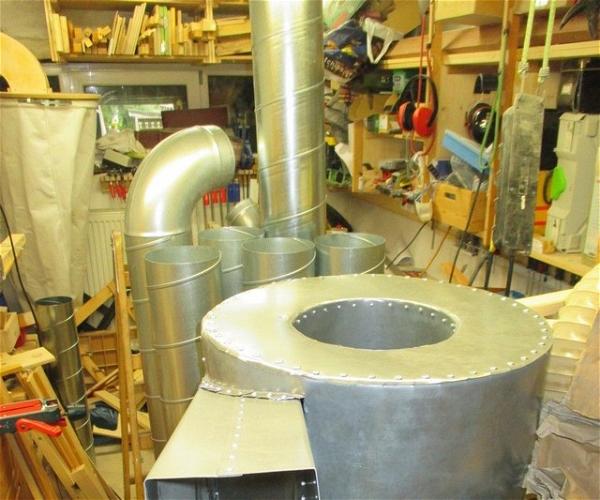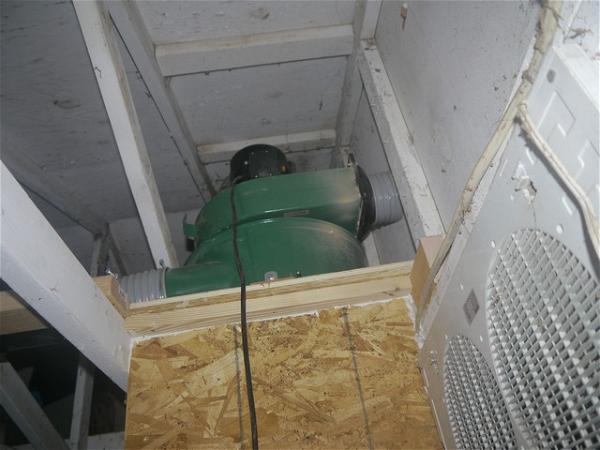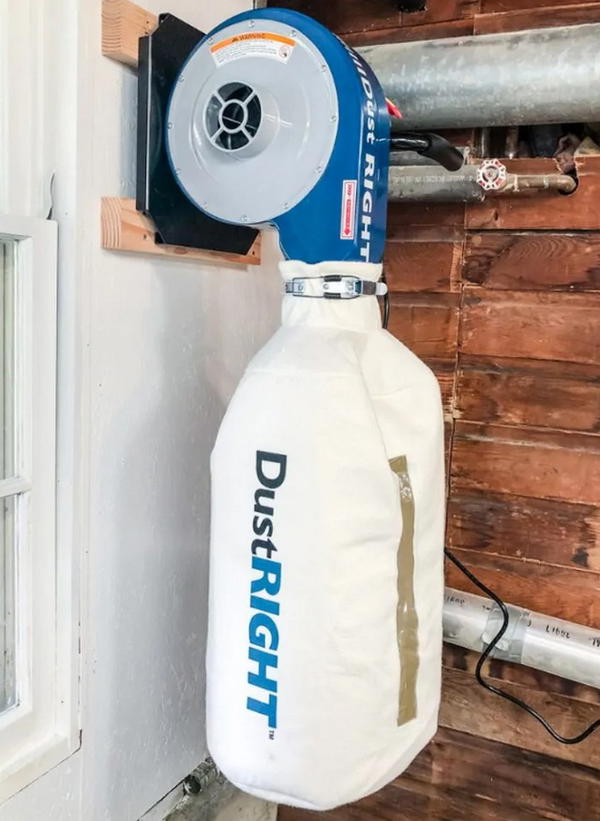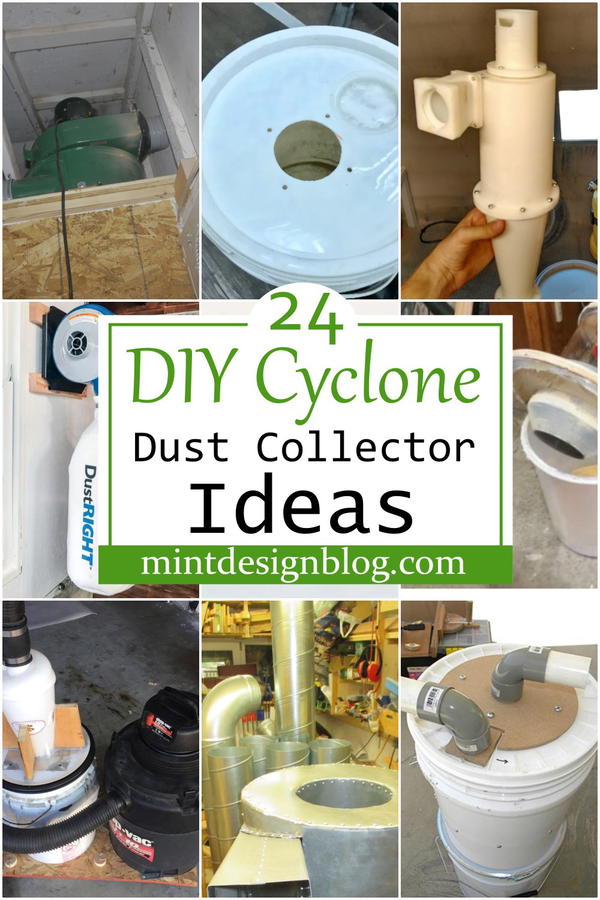You can now create your own dust collectors at home by following the 24 DIY Cyclone Dust Collector Plans. These DIY cyclone dust collectors come with top-of-the-line features such as a dual vortex design, high efficiency, and low noise operation compared to other available commercial ones. The DIY Cyclone Dust Collector Plans are easy to follow and require inexpensive materials for creation. Once you've finished, you can use them in your workshop or garage for household purposes, from collecting sawdust from woodworking projects to removing small debris from your shop floor after sanding small pieces of metal down!
DIY Cyclone Dust Collector

Save Money To Build On Your Own:
Some DIYers don't want to spend extra money to buy a more expensive cyclone dust collector and prefer to build one that's good enough for their needs. With our DIY Cyclone Dust Collector Plans, you can make as many cyclones as you need at a fraction of the price an official one costs. We'll assist you with easy-to-follow guides for making your own cyclone dust collector in no time! You only need to follow the steps carefully, and you can make as many as you want.
Uses And Benefits:
The DIY cyclone dust collector is a great tool for everyone who wants to make something at home. This is because it is easy to build and comes in handy when we want to recycle old paper and garbage into beautiful decorations. These DIY dust collectors have a lot of benefits, such as saving on energy bills, keeping harmful dust particles, reducing noise levels, and making work easier because only clean air will escape through the vent hose—no sounds or extra effort required.
These homemade cyclones are easy to build by following the instructions in these DIY guides. They're easy, cheap to make, and can be used for various purposes, such as in your workshop, garage, or home. Each guide will walk you through the process with step-by-step instructions and useful visuals to make your very own dust collector easily!
Jet Cyclone Dust Collector Plan

This budget-friendly cyclone dust collector will help you clean and tidy your workshop. Wooden frames, metal sheets, and screws are used to build the body of this collection. The base is made of 5-inch thick plywood, while the same type of wood is used to make the lid. This cyclone dust collector uses a blower set-up that pulls air through a central port by an impeller mounted on a steel shaft. This is sent into the top of the barrel, allowing particles to drop out of the cyclone chamber, which is collected in an attached shop vac bag system.
Materials and tools:
- Some sheets of metal
- plywood
- wood glue
- screws
- aluminum-plated sealing tape
DIY Cyclone Dust Collector

If you want to make your own 3D Printer but don't know how or don't have the money for a commercial model, this is an excellent way to get your feet wet with a powerful tool that can be customized in many ways. The Cyclone Dust Collector is ideal for use with desktop 3D printers. This dust collector can help you save money on expensive filament by reducing the material wasted when printing. The powerful fan creates a cyclone of air that pulls in particles and debris from your prints, separating them from the clean air and collecting everything in an easy-to-empty waste container. The flexible joint design allows you to adjust the angle of the fan to best direct airflow towards your Printer.
Materials and tools:
- Flex filament for joints
- PLA OR ABS filament for the rigid parts
- heat threaded inserts
- A lot of screws.
Make A DIY Cyclone Dust Collector
The first step in creating this cyclone dust collector is to build the frame, mainly plywood. To make it strong and sturdy, you’ll need to glue the thicknesses together while ensuring they are parallel. Once everything is glued properly, attach the casters with bolts on each corner. The next step involves attaching the cyclone dust collector and attaching it to the hinge so you can fold it when not in use. You also need to attach a vacuum piping system and a filter bag so fine particles from your workshop or garage don’t get lost in the air.
Materials and tools:
- Plywood for the frame
- a 5-gallon bucket
- two small toggle clamps
- a piano hinge, four casters
- a cyclone dust collector,
- some vacuum piping set
Mini Cyclone Bucket Dust Collector DIY

Mini Cyclone Dust Collector is a great homemade dust collector that is easy and quick to make. It’s powered by a vacuum cleaner and uses centrifugal force to separate the heavier dust particles from the airflow. This allows you to collect dust at a fraction of the cost of traditional industrial cyclones, saving you money while saving more electricity. When making this inexpensive DIY dust collector, safety must always be considered first.
Materials and tools:
- A plastic paint bucket
- a plastic funnel
- a vacuum cleaner
- bolts
- nuts
- washers
- pieces of plywood
DIY Dust Collector Cyclone
If you have a dust collector in your workshop, this DIY dust collector cyclone guide will be the best one for you. The creator will show you how he turned his chiseled collection unit into an ultimate cyclone in this video tutorial. This upgrade can only work for carbon-free or any other kind of dust collectors at home because it uses them to build a cyclone. It will help you save more space in your workshop, save power, and produce less noise too.
Materials and tools:
- Some metal sheets
- some scrap plywood
- a big barrel
How To Make A Simple Cyclone Dust Collector
While you may have your own idea of what makes a great dust collector, sometimes it’s best to hear from others. The great thing about this dust collection system is that it was built with items that can easily be found and are not too expensive. It is also very effective at protecting the workers from particulates in the air while they work on their projects. This helps ensure that there will be fewer health problems and long-term benefits for everyone involved.
Materials and tools:
- Some PVC pipe
- Plexiglass
- acrylic silicone
- a large board
- pieces of wood
- some screws.
DIY Cyclonic Dust Extractor
The DIY cyclone dust extractor is a popular tool used by woodworkers and artisans to create their work area safely. This video tutorial guide shows how the extractor works and provides a list of important materials and tools needed. It requires materials and tools that are not readily available and can be expensive. That’s why we decided to make a video tutorial guide with all the necessary materials, tools, and steps to build your own cyclone dust collector. It’s easy to follow along and apply to any DIY projects at home.
Cheap Cyclone Dust Collector Plan

This is a dust collector that will work great as long as you put some effort into finding the right parts. It costs only $36, and once built, it creates a vortex in the center of a plastic trash can, capturing all dust carried by the inlet hole on top. This gets sucked into the trashcan via a flexible hose or pipe. If you’re just getting started in DIYing or don’t have much money for fancy equipment, this cyclone dust collection unit is perfect for you.
Materials and tools:
- DIY cyclone dust separator
- 50mm vacuum hose
- Empty a 5-liter paint bucket with a plastic lid
- Some random hose adaptors
- Some random hose adaptors
DIY Dust Cyclone Under $2
Dust is a major problem for all woodworkers, especially those using power tools like routers and table saws. There are many commercial dust collection systems on the market, but many are quite expensive and require more than one hose to connect to your tool, which can become a real hassle. For this reason, people choose to build their own dust cycle from scratch. This DIY Dust Cyclone Under $2 will show you how to create an effective, easy-to-build dust collector that is much cheaper than what’s available today.
Materials and tools:
- a paint bucket
- paint brush or paint spray
- some PVC pipe elbows
- Drilling machine
Homemade Cyclone Dust Collector Plan

Now you can build your own cyclone dust collector using the design people have used for over a decade. This design is simple, efficient, and effective. Featuring the latest technology, this cyclone dust collector has revolutionized traditional methods of building cyclones for home shops. With this cyclone dust collector design, you can easily empty the 5-gallon bucket. The vacuum filter can last five times longer than normal before needing to be cleaned or replaced, and also gives you control over when to empty it by viewing it through the black window in front.
Materials and tools:
- two boards are ¾" plywood
- 5-liter gallon bucket
- Vacuum system
How To Connect A Cyclone Dust Collector

In this project, you will go through the steps of making a cyclone dust collector. This is a great project because it will help you create something useful and teach you the basic tools used to make a soldering gun and connect wires. You can use this dust collector as part of your workshop equipment or as a standalone product such as on a computer desk, etc. The making process is simple to follow and can be completed with basic skills.
Materials and tools:
- a 5-gallon plastic tube
- a hot glue gun
- a soldering gun
- a jigsaw
How To Make Cyclone Dust Collector From Vacuum Cleaner
The cyclone dust collector is a super choice to remove dust from your workshop or garage since it operates on centrifugal force. In this easy-to-follow tutorial, you'll learn how to make your own cyclone dust collector according to the instructions. The best thing is that you don't even need any special tools. Making one yourself is quite easy and will save you the money you would have had to spend on a store-bought cyclonic vacuum cleaner.
Materials and tools:
- plastic water bottle
- some PVC pipe
- a 12V DC motor
- a mini food container
Best Cyclone Dust Collector Idea

The cyclone dust collector is a component that collects dust and particles in a controlled manner. It is commonly used in workshops and industrial environments, where a great deal of dust is produced. The cyclone dust collector includes a motor and blower unit, normally attached to the wall or ceiling. This project can be done by experienced and passionate DIYers who want to try something out of the ordinary. Only technical skills are required, but if you don’t want to waste your time searching for information, you can get a full guide from here.
Materials and tools:
- ½” OSB plywood
- Glue
- Latex caulk to seal the dust box
- 4" PVC duct pipes
- 2 Harbor freight dust collector
How To Make Cyclone Dust Separator
Dust is a major problem when you're in the workshop. The better solution is to use a cyclone dust collector like this one. The dust collector separates the dust from the air and cleans it before entering your face. In this video, we'll show you how to make a cyclone dust separator or one of the most powerful shops dust collectors in its price range. Utilizing only a few common parts and simple tools, this thing will separate 90 per cent of all sawdust from the air flowing through it.
Materials and tools:
- A 5-gallon buck"t
- 12" piece of small hose
- A hand saw
- some duct tape
High-Efficiency Cyclone Dust Collector
By following this video guide, make a high-efficiency cyclone dust collector in a couple of hours. You can make this powerful, high-efficiency cyclone dust collector in a couple of hours with a few simple tools. It will help clean and purify your workshop, garage, or home office. The realtor's cyclone dust collector is super efficient with his homemade vacuum cleaner. With this homemade vacuum cleaner, you can save money on cleaning and stay healthy because there will be no more dust floating around your house.
Materials and tools:
- A 5-liter empty bucket
- Duct tape
- A large hose
- 2 elbow joints
- Vacuum system
Wall Mount Cyclone Dust Collector DIY

The Wall Mount Dust Collector keeps your workstation neat and tidy by creating a sealed environment. It can be mounted close to the dust source to collect it when it needs cleaning up. A wall-mounted dust collector is a great way to get the job done, no matter how small or confined your space is. The compact design of this wall-mounted dust colletor allows easy access to the dust collector and filter, making it more efficient than most cyclone dust collectors. Its installation is quick and easy, and it doesn’t take up much space at all.
Materials and tools:
- miter saw stand
- miter saw dust hood
- expandable dust hose
- benchtop tool stand
- additional Z brackets
- 5-micron dust filter
Street Cone DIY Dust Collector
To make a cyclone dust collector with a street cone, first, you need to buy a 5-gallon bucket with lid and PVC pipe. Next, cut out a hole in the top of the bucket lid. Set up your plywood ring, then drill holes through both your block and the plywood for drainage. Drill holes into your drywall screws at the bottom of your ring too. Next, glue plexiglass onto your bale with construction adhesive or silicone caulk. Then cut out another hole in the bottom of your lid for the power cord that runs outside. Use 2x4s to build a stand so that no one trips over it or steps on it when it’s not in use.
Materials and tools:
- A 5-gallon bucket with a lid
- PVC pipe
- pinewood
- plywood
- drywall screws
- plexiglass
- a few other screws
5 Minute Cyclone Dust Collector
Dust is the enemy of most woodworkers and craftsmen. It’s important to clear the air in your workspace effectively, so you can avoid breathing in unhealthy particles and keep your work area clean. This video tutorial guide teaches you how to make a cyclone dust collector with a mini shop vacuum cleaner and a bucket in just 5 minutes. This is an efficient way to create an effective dust collector while minimizing costs.
Materials and tools:
- a mini shop vacuum cleaner
- a bucket
- some helpful tools
Dust Separator With Two Buckets
Dust collection is important in the woodworking or DIYer’s workshop. Dust collection helps to keep you exposed to dust, which can harm your health and frequently occur when you cut and sand wood. Using a cyclone dust collector, you can get rid of some of this dust, but it can be expensive. This DIY cyclone dust separator is made from two buckets. It is more effective than a single bucket because the second one catches all the fine particles that get past the first one. The technology behind this device isn’t new, but it’s quite effective in separating dust from larger debris when used with a shop vacuum like this.
Materials and tools:
- two buckets
- plywood
- silicone
- epoxy glue
- PVC pipe
- a few wood screws
Cyclone Dust Collector DIY
The cyclone dust collector is a simple yet effective tool to manage the mess and debris that can fly around your workshop. It’s also an excellent way to get small particles out of the air in your workspace, which can cause respiratory issues. This cyclone dust collector is for you if you want something simple, fast, and inexpensive. You can build this powerful tool with the right supplies and less than 10 minutes of your time. This DIY project can easily be adjusted to fit your needs and will knock down the level of dust in your workshop in no time.
Materials and tools:
- An empty bucket
- Some ducts
- Duct tape
- A hose
Simple Cyclone Dust Collector
The cyclone dust collector is an efficient and effective way of collecting dust. This instructional video guides you through the necessary steps in making a simple cyclone dust collector from PVC pipes. The steps involve cutting the pipes, gluing them together, adding elbow joints to increase the diameter, connecting them with a shop vacuum cleaner, and testing to see if it works effectively. The tool cost is only close to $50, so it is a good investment if you want to get your own dust collector.
Materials and tools:
- Some PVC pipes
- Glue
- PVC pipe elbows
- A pretty effective shop vacuum cleaner
Homemade PVC Cyclonic Dust Collector
In this homemade PVC cyclonic dust collector guide, we will go through the process of making an easy-to-make cyclone dust collector. This project does not require a lot of time or skills and can be completed in about 4 hours. These instructions involve cutting, drilling, and sanding PVC pipes so they can be assembled to form one functional device. After an overview of all the tools used, we'll take you step-by-step through each section and see how to put everything together properly.
Materials and tools:
- 100mm PVC pipe
- 40mm PVC pipe
- 100 to 40 adaptor
- A shop-vac.
DIY Cyclone Dust Collector
This homemade dust collector is designed to capture sawdust, wood chips, and other waste material generated by the vacuum itself. Using two 5-gallon buckets and a shop-vac, the cyclone dust collector captures most of the wood shavings and other materials inside a closed system, then deposits them into a container for easy disposal. It's easy to build, and a result is a powerful tool that can handle any job site debris.
Materials and tools:
- Two 5-gallon buckets
- A shop-vac
- Two hoses
DIY Cheap Cyclone Dust Collector
This cyclone dust collector might be expensive for some, but it's worth every penny. You'll want to use a good shop vacuum with a HEPA filter hooked up to your miter saw that you plan on using this collector with, and boy, howdy will it keep your shop tidy and clean. The ducts are conveniently attached to the base via clamps, where they are easily removed in case of damage or when it needs cleaning. The build process is simple, and the steps are easy to follow; it requires some knowledge of power tools and carpentry skills, be sure to wear eye protection, gloves, and ear protection.
Materials and tools:
- An empty bucket
- A vacuum cleaner
- A miter saw
- Ducts
- Clamps
- Duct tape
- Some PVC pipes

See Other Projects





